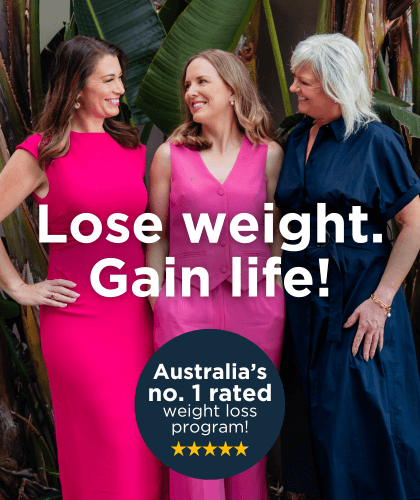How You Can Improve Your CSIRO Healthy Diet Score

The latest findings from the CSIRO Healthy Diet Score have been released, and the report reveals that many Australians are falling short in making nutritious choices for their health and wellbeing. Australian have averaged 55/100 since the survey began. But looking year-on-year, the average diet score has decreased from 56 in 2015 to 53 in 2023.
Dr. Gilly Hendrie, CSIRO Senior Research Scientist and co-author of the CSIRO Healthy Diet Score report, says that while Australians are often perceived as fit and healthy, the collective low score indicates that we barely meet the minimum requirements set by national dietary recommendations.
“The score is a stark reminder of the work that needs to be done to improve our eating habits and reduce the national waistline,” Dr Hendrie said.
The encouraging news is that a healthier diet is within reach through simple adjustments.
“The things to keep in mind is reduce, increase, and add variety. In other words, reduce the number of discretionary foods being consumed, increase healthy foods including fruit and dairy and alternatives, and aim for variety by eating three or more different types of vegetables with your main meal.”
RELATED: View the 2023 Diet Score Infographic here.
Tips for improving your CSIRO Healthy Diet Score
The CSIRO Healthy Diet Score is a short food survey that looks at your current diet and compares what you are consuming with the 2013 Australian Dietary Guidelines (ADGs) and Australian Guide to Healthy Eating (AGHE), giving a diet quality score out of 100. With the average Australian scoring around 55/100 in 2023, there is plenty of room for improvement!
Here are our top tips for improving your Healthy Diet Score:
Increase your intake of healthy foods
Spring offers an ideal opportunity to enhance your meals with fresh fruits, including seasonal options like berries, kiwifruit, stone fruits, and apples. Frozen fruits can provide quality and cost-effective alternatives.
Shift away from fatty oils, butter, and rich sauces. Opt for flavour-enhancing alternatives like lemon and herbs or tomato-based sauces like Romesco, Napolitano, arrabiata, or marinara. Consider incorporating flavour-packed ingredients such as garlic, ginger, capers, and olives into your meals.
Don't overlook dairy, which should be both quality and quantity. The Australian Dietary Guidelines recommend at least 2.5 serves a day of milk (preferably low fat), cheese, yoghurt, and/or alternatives for most adults aged 19-50. A serve from the dairy food group includes a cup (250ml) of milk, three-quarters of a cup (200g) of yoghurt, two slices (40g) of cheese, half a cup (120g) of ricotta cheese, or appropriate alternatives.
RELATED: This fresh, fruity smoothie is a great option for busy mornings when you don’t have time for a sit-down breakfast and it satisfies one of your dairy units for the day!
Reduce Discretionary Foods
According to the Healthy Diet Score, Australians consume an average of 28 servings of discretionary foods per week, including items like cakes, biscuits, chocolate, confectionery, and takeaway meals. While it's essential to indulge occasionally, it's crucial to be mindful and consider ways to reduce your intake.
- Slice and share: Reduce portion sizes of junk food; consider sharing treats with friends to curb overindulgence.
- Out of pantry, out of mind: Tailor your approach to temptation; stock your kitchen with fewer indulgent options if needed.
- Exercise for cravings: Prioritise physical activity before reaching for treats; endorphins can help combat cravings.
- Find healthy alternatives: Select healthier alternatives when cravings strike, such as nuts, veggie sticks with hummus, air-popped popcorn, and dark chocolate. Explore nutritious indulgence recipes like lemon bliss balls and choc black bean brownies on our Total Wellbeing Diet website.
Eat a variety of vegetables
The average vegetable score stands at 58 out of 100, with only four out of 10 adults consuming three or more different vegetables at their main meal, which indicates a healthy diet. To improve your Diet Score:
- Include a variety of fruits and vegetables in your meals and snacks. Vegetables are high in water, low in kilojoules, rich in fibre, and packed with antioxidants, vitamins, and minerals. You can generally eat them in abundance without impacting your waistline.
- Aim for at least three different types of vegetables with your main meal. They should make up about 50 percent of your plate.
- Experiment with vegetable alternatives like spiralized carrots, zucchinis, and sweet potatoes. Use cauliflower as a rice alternative. Incorporate grated carrot, broccoli, celery, capsicums, and mushrooms into various dishes.
- Add crunch with fresh vegetables, seeds, and nuts for a satisfying mouth-feel. Pre-cut veggies like carrot, celery, cucumber, and capsicum are great for snacks with hummus or salsa dip. Pre-cooked vegetables like cauliflower, sweet potato, and pumpkin can also be convenient options.
Real success stories: How our members improved their Healthy Diet Score
Our Total Wellbeing Diet community is living proof of the power of positive change. Many of our members have successfully improved their Diet Score and transformed their lives for the better, such as our member Christian.

Before Christian embarked on his life-changing journey with the CSIRO Total Wellbeing Diet, he took the Healthy Diet Score assessment, scoring just 35/100 – well below the average. Since joining our program, he has achieved incredible results. Christian's diet score has soared to 87/100, a testament to his dedication and our program's effectiveness. Not only that, but he has shed a remarkable 40 kgs, transforming his life in more ways than one!
"Your first Diet Score is an opportunity to start walking from base camp to the very top of your best health and nutrition. Aim for 100% and then climb the ladder one score at a time, every increase to your score is a successful step worth celebrating as you take more control of your health and life," he said.
"It's easy to feel discouraged by low scores, and high kgs and cms, but the Diet Score report has the answers to your nutrition questions, and provides the advice you need to make informed decisions every step of the way."
"Completing the Diet Score survey again to find I achieved '87' helped me measure my success beyond centimetres and kilograms, it shows that nutrition is second nature to me now and more my main interest, rather than an after thought."
Join us in your journey to Total Wellbeing
Now is the perfect time to take control of your health and wellbeing. By becoming a member of the CSIRO Total Wellbeing Diet, you'll gain access to personalised meal plans, expert guidance, and a supportive community to help you achieve your goals.
Don't let unhealthy eating habits hold you back any longer. Take the Diet Score quiz, explore our Healthy Diet Score report, and consider joining the Total Wellbeing Diet community to embark on a path to a healthier, happier you!


